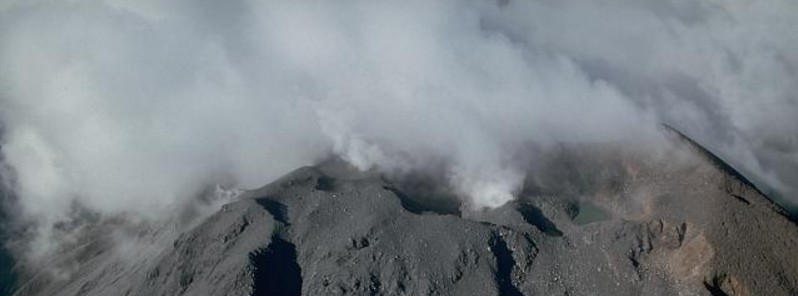Small phreatic eruption at Bulusan volcano, Philippines

A minor phreatic eruption took place at Bulusan volcano, Luzon, Philippines at 14:29 UTC (22:29 local time) on June 5, 2017. The last eruption of this volcano, also phreatic, took place on March 2, 2017.
Based on the seismic record, the eruption lasted approximately 12 minutes, but could not be observed visually due to thick clouds covering the summit.
Traces of ash, sulfuric odor, and rumbling sound were reported in Brgys. Monbon and Cogon in Irosin while sulfuric odor was observed at Brgy. Bolos, Irosin, Sorsogon., PHIVOLCS reported today.
In the past 24 hours (by midnight UTC on June 6), Bulusan Volcano’s seismic monitoring network recorded 3 volcanic earthquakes. Weak to moderate emission of white steam plumes that rose up to 50 m (164 feet) before drifting northeast was observed coming from the active vents. Sulfur dioxide (SO2) emission was measured at an average of 8 tons/day on April 29, 2017. Precise leveling data obtained on January 29, 2017 – February 03, 2017 indicated deflationary changes since October 2016. This is consistent with data from continuous GPS measurements that indicated short-term deflation of the edifice since January 2017. However, the edifice remains generally inflated with respect to July 2016 based on continuous GPS data.
Alert Level 1 (abnormal) status remains in effect over Bulusan Volcano, which means that it is currently in a state of unrest probably driven by hydrothermal processes that could generate steam driven or phreatic eruptions.
Local government units and the public are reminded that entry into the 4-km (2.5 miles) radius Permanent Danger Zone (PDZ) is strictly prohibited and that vigilance in the Extended Danger Zone (EDZ) must be exercised due to the increased possibilities of sudden and hazardous phreatic eruptions.
Civil aviation authorities must also advise pilots to avoid flying close to the volcano’s summit as ash from any sudden phreatic eruption can be hazardous to aircraft.
Furthermore, people living within valleys and along river/stream channels especially on the southeast, southwest and northwest sector of the edifice should be vigilant against sediment-laden stream flows and lahars in the event of heavy and prolonged rainfall.
A sudden phreatic eruption at the volcano on May 7, 2013 killed 5 people who were within the danger zone.
Geological summary
Luzon's southernmost volcano, Bulusan, was constructed along the rim of the 11-km-diameter (6.8 miles) dacitic-to-rhyolitic Irosin caldera, which was formed about 36 000 years ago. Bulusan lies at the SE end of the Bicol volcanic arc occupying the peninsula of the same name that forms the elongated SE tip of Luzon. A broad, flat moat is located below the topographically prominent SW rim of Irosin caldera; the NE rim is buried by the andesitic Bulusan complex.
Bulusan is flanked by several other large intracaldera lava domes and cones, including the prominent Mount Jormajan lava dome on the SW flank and Sharp Peak to the NE. The summit of 1 565-m-high (5 134 feet) Bulusan volcano is unvegetated and contains a 300-m-wide (984 feet), 50-m-deep (164 feet) crater. Three small craters are located on the SE flank. Many moderate explosive eruptions have been recorded at Bulusan since the mid-19th century. (GVP)
Featured image: Mount Bulusan, Philippines. Credit: Chris Newhall (USGS).

Commenting rules and guidelines
We value the thoughts and opinions of our readers and welcome healthy discussions on our website. In order to maintain a respectful and positive community, we ask that all commenters follow these rules.